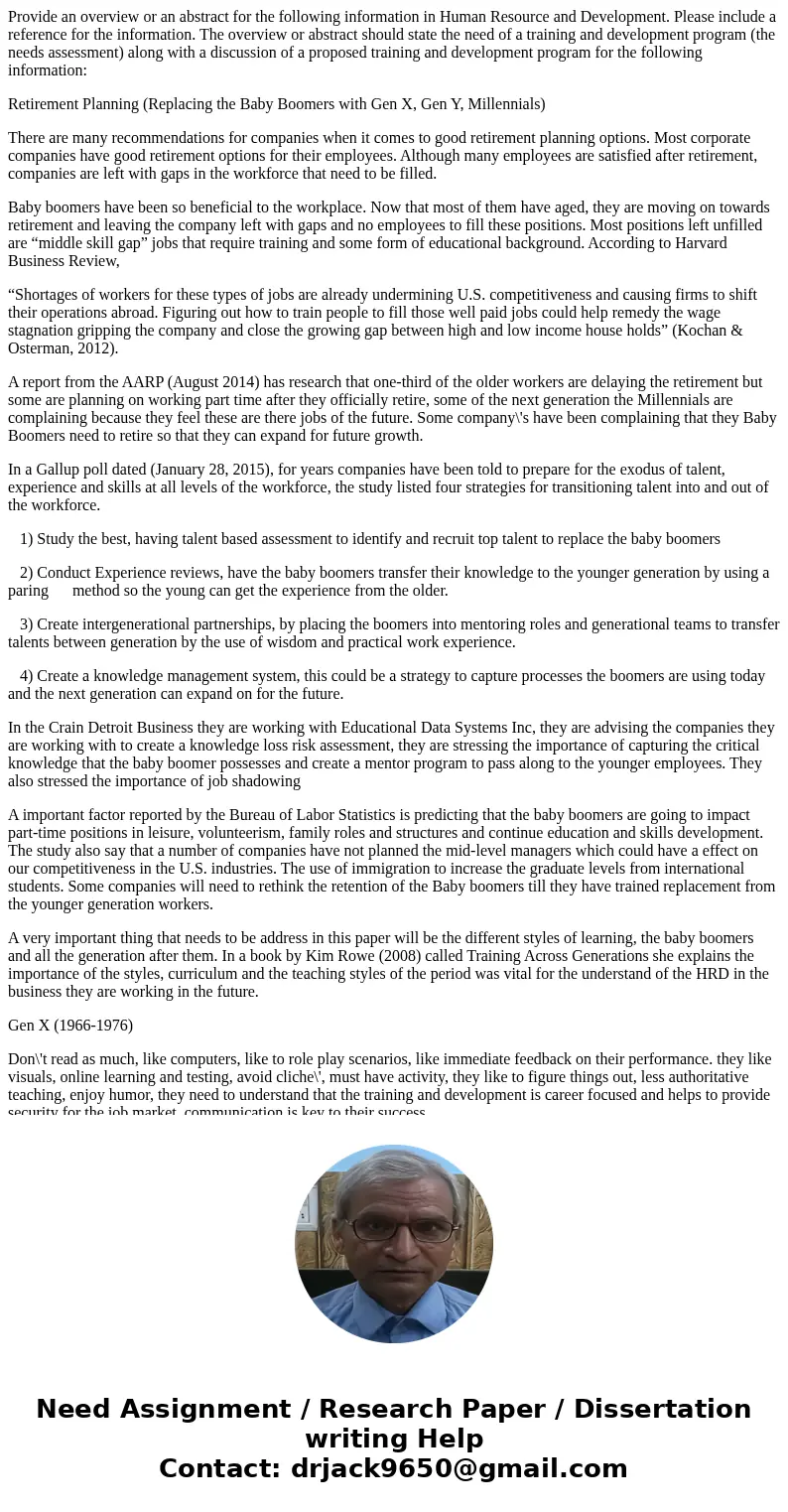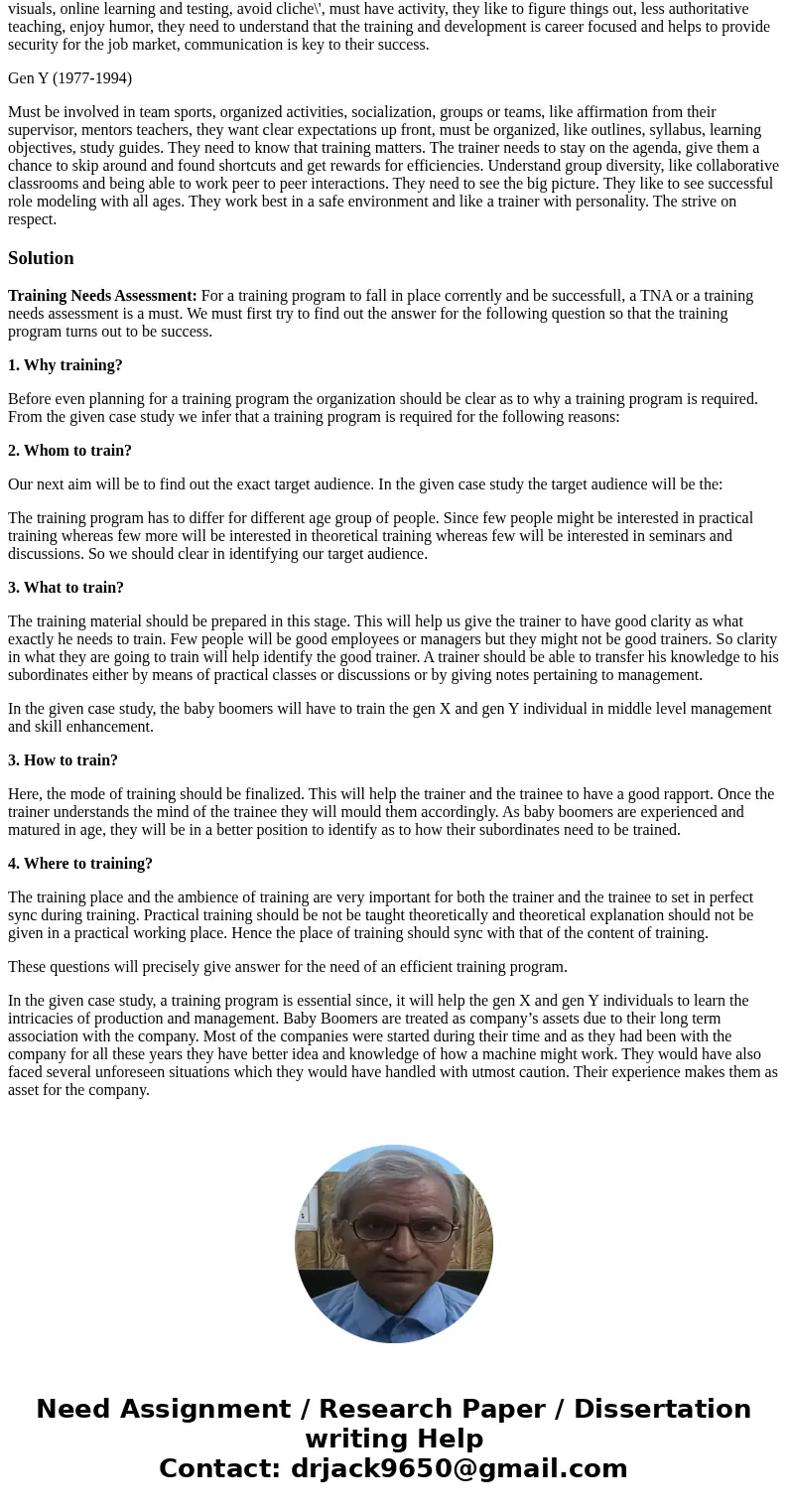Provide an overview or an abstract for the following informa
Provide an overview or an abstract for the following information in Human Resource and Development. Please include a reference for the information. The overview or abstract should state the need of a training and development program (the needs assessment) along with a discussion of a proposed training and development program for the following information:
Retirement Planning (Replacing the Baby Boomers with Gen X, Gen Y, Millennials)
There are many recommendations for companies when it comes to good retirement planning options. Most corporate companies have good retirement options for their employees. Although many employees are satisfied after retirement, companies are left with gaps in the workforce that need to be filled.
Baby boomers have been so beneficial to the workplace. Now that most of them have aged, they are moving on towards retirement and leaving the company left with gaps and no employees to fill these positions. Most positions left unfilled are “middle skill gap” jobs that require training and some form of educational background. According to Harvard Business Review,
“Shortages of workers for these types of jobs are already undermining U.S. competitiveness and causing firms to shift their operations abroad. Figuring out how to train people to fill those well paid jobs could help remedy the wage stagnation gripping the company and close the growing gap between high and low income house holds” (Kochan & Osterman, 2012).
A report from the AARP (August 2014) has research that one-third of the older workers are delaying the retirement but some are planning on working part time after they officially retire, some of the next generation the Millennials are complaining because they feel these are there jobs of the future. Some company\'s have been complaining that they Baby Boomers need to retire so that they can expand for future growth.
In a Gallup poll dated (January 28, 2015), for years companies have been told to prepare for the exodus of talent, experience and skills at all levels of the workforce, the study listed four strategies for transitioning talent into and out of the workforce.
1) Study the best, having talent based assessment to identify and recruit top talent to replace the baby boomers
2) Conduct Experience reviews, have the baby boomers transfer their knowledge to the younger generation by using a paring method so the young can get the experience from the older.
3) Create intergenerational partnerships, by placing the boomers into mentoring roles and generational teams to transfer talents between generation by the use of wisdom and practical work experience.
4) Create a knowledge management system, this could be a strategy to capture processes the boomers are using today and the next generation can expand on for the future.
In the Crain Detroit Business they are working with Educational Data Systems Inc, they are advising the companies they are working with to create a knowledge loss risk assessment, they are stressing the importance of capturing the critical knowledge that the baby boomer possesses and create a mentor program to pass along to the younger employees. They also stressed the importance of job shadowing
A important factor reported by the Bureau of Labor Statistics is predicting that the baby boomers are going to impact part-time positions in leisure, volunteerism, family roles and structures and continue education and skills development. The study also say that a number of companies have not planned the mid-level managers which could have a effect on our competitiveness in the U.S. industries. The use of immigration to increase the graduate levels from international students. Some companies will need to rethink the retention of the Baby boomers till they have trained replacement from the younger generation workers.
A very important thing that needs to be address in this paper will be the different styles of learning, the baby boomers and all the generation after them. In a book by Kim Rowe (2008) called Training Across Generations she explains the importance of the styles, curriculum and the teaching styles of the period was vital for the understand of the HRD in the business they are working in the future.
Gen X (1966-1976)
Don\'t read as much, like computers, like to role play scenarios, like immediate feedback on their performance. they like visuals, online learning and testing, avoid cliche\', must have activity, they like to figure things out, less authoritative teaching, enjoy humor, they need to understand that the training and development is career focused and helps to provide security for the job market, communication is key to their success.
Gen Y (1977-1994)
Must be involved in team sports, organized activities, socialization, groups or teams, like affirmation from their supervisor, mentors teachers, they want clear expectations up front, must be organized, like outlines, syllabus, learning objectives, study guides. They need to know that training matters. The trainer needs to stay on the agenda, give them a chance to skip around and found shortcuts and get rewards for efficiencies. Understand group diversity, like collaborative classrooms and being able to work peer to peer interactions. They need to see the big picture. They like to see successful role modeling with all ages. They work best in a safe environment and like a trainer with personality. The strive on respect.
Solution
Training Needs Assessment: For a training program to fall in place corrently and be successfull, a TNA or a training needs assessment is a must. We must first try to find out the answer for the following question so that the training program turns out to be success.
1. Why training?
Before even planning for a training program the organization should be clear as to why a training program is required. From the given case study we infer that a training program is required for the following reasons:
2. Whom to train?
Our next aim will be to find out the exact target audience. In the given case study the target audience will be the:
The training program has to differ for different age group of people. Since few people might be interested in practical training whereas few more will be interested in theoretical training whereas few will be interested in seminars and discussions. So we should clear in identifying our target audience.
3. What to train?
The training material should be prepared in this stage. This will help us give the trainer to have good clarity as what exactly he needs to train. Few people will be good employees or managers but they might not be good trainers. So clarity in what they are going to train will help identify the good trainer. A trainer should be able to transfer his knowledge to his subordinates either by means of practical classes or discussions or by giving notes pertaining to management.
In the given case study, the baby boomers will have to train the gen X and gen Y individual in middle level management and skill enhancement.
3. How to train?
Here, the mode of training should be finalized. This will help the trainer and the trainee to have a good rapport. Once the trainer understands the mind of the trainee they will mould them accordingly. As baby boomers are experienced and matured in age, they will be in a better position to identify as to how their subordinates need to be trained.
4. Where to training?
The training place and the ambience of training are very important for both the trainer and the trainee to set in perfect sync during training. Practical training should be not be taught theoretically and theoretical explanation should not be given in a practical working place. Hence the place of training should sync with that of the content of training.
These questions will precisely give answer for the need of an efficient training program.
In the given case study, a training program is essential since, it will help the gen X and gen Y individuals to learn the intricacies of production and management. Baby Boomers are treated as company’s assets due to their long term association with the company. Most of the companies were started during their time and as they had been with the company for all these years they have better idea and knowledge of how a machine might work. They would have also faced several unforeseen situations which they would have handled with utmost caution. Their experience makes them as asset for the company.


 Homework Sourse
Homework Sourse